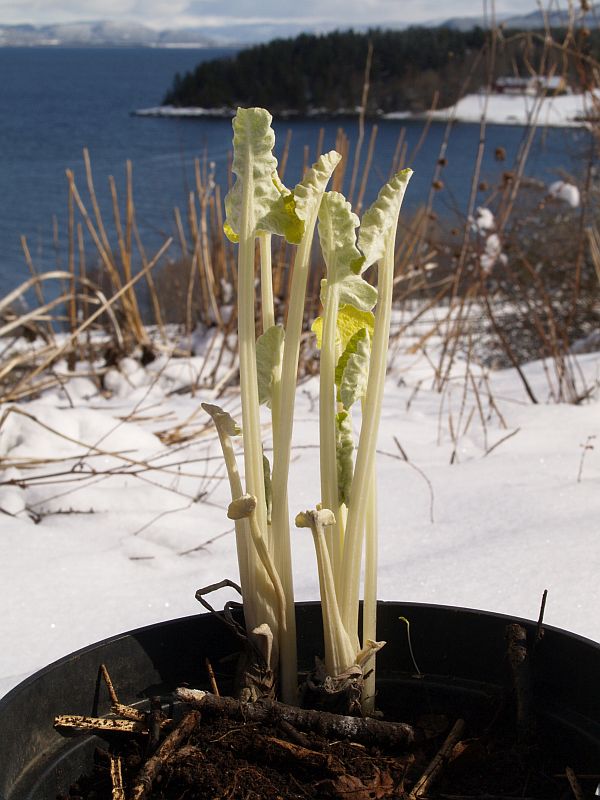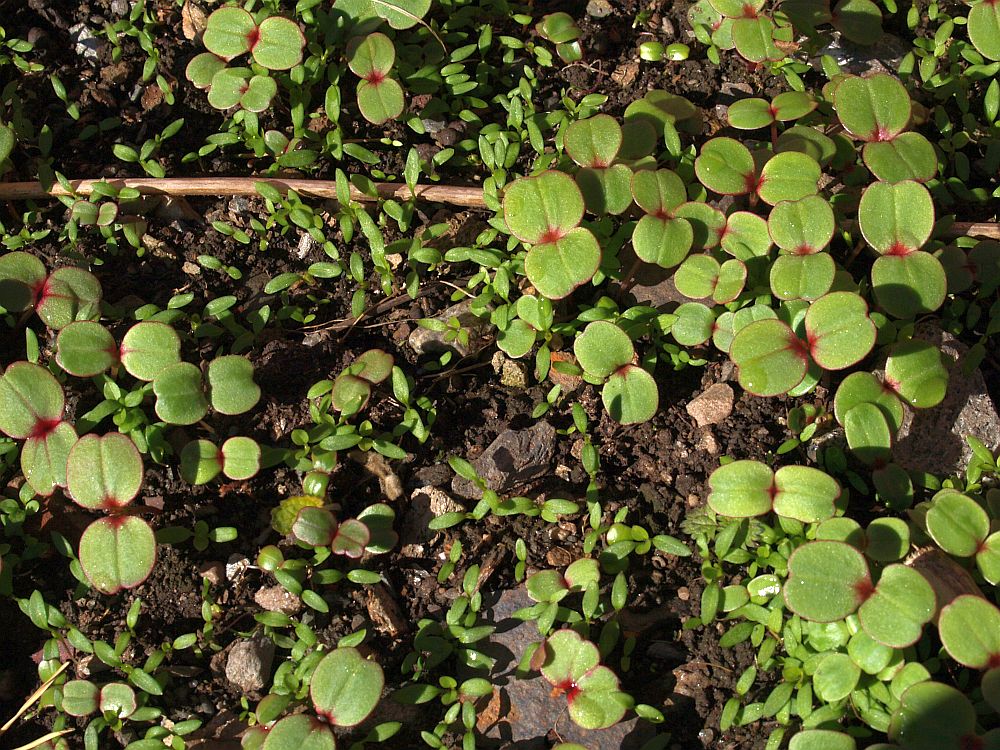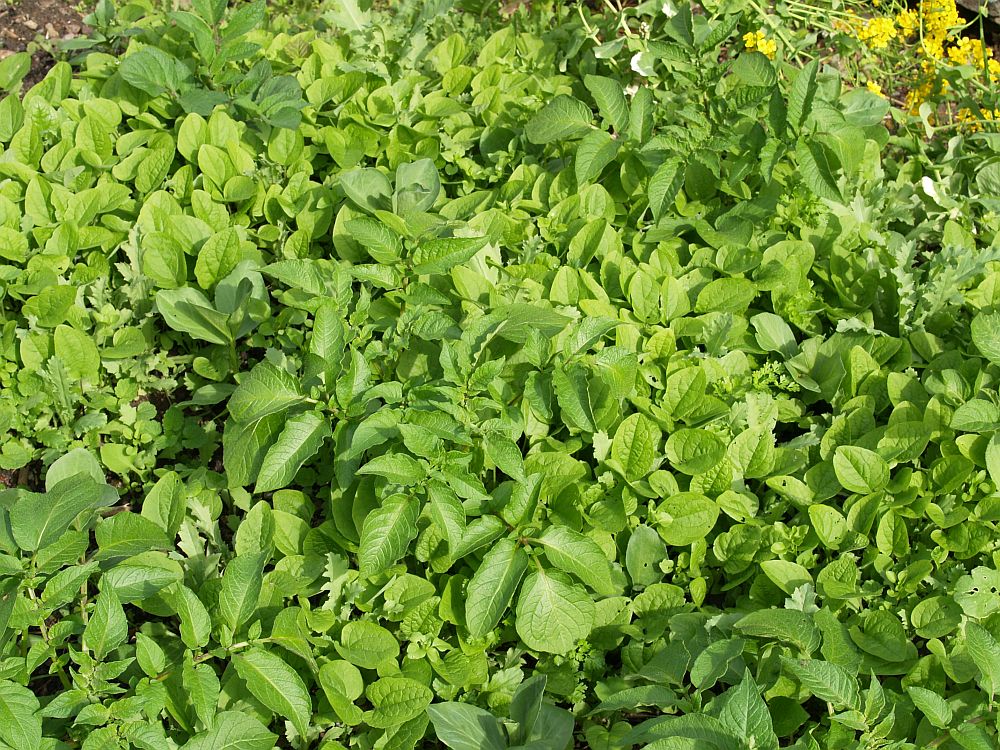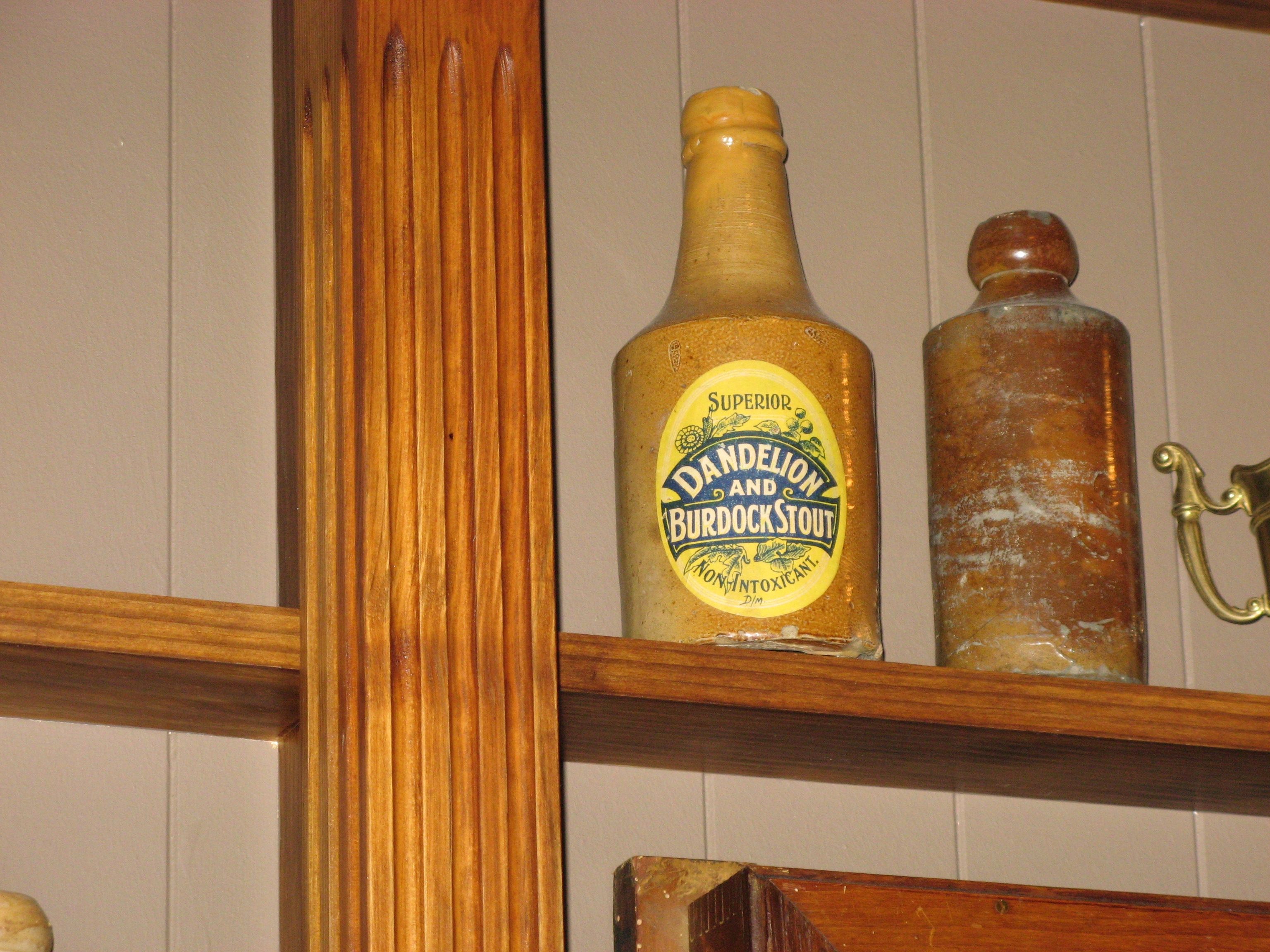We occasionally eat wild fish and bacalhau is a favourite made from Norwegian dried cod that can be found in supermarkets here. More or less anything goes in bacalhau (bacalao) and although most people make it in the same way – layers of potato, fish, tomato and onions, often with chili – the Portuguese have hundreds of ways of preparing baccalao (dried cod). Being self-sufficient, detailed recipes aren¨’t useful and we use whatever is available at the moment. Winter is the time for stored bulbs, corms, tubers, rhizomes, and taproots. See below the picture for yesterday’s baccalao ingredients with 14 home grown below surface storage organs plus some greens (I’m pretty sure nobody else had this version of the dish…ever!):
Oca (Oxalis tuberosa): yellow and red varieties
Garlic / hvitløk (Allium sativum)
Wapato (Sagittaria latifolia)
Potato / potet (Solanum tuberosum) – 2 varieties
Jerusalem artichokes / jordskokk (Helianthus tuberosus)
Parsnip / pastinakk (Pastinaca sativa)
Scorzonera / scorsonerrot (Scorzonera hispanica)
Common onion / kepaløk (Allium cepa)
Cacomitl (Tigridia pavonia)
Yacon (Polymnia sonchifolia)
Burdock / storborre (Arctium lappa)
Madeira vine (Anredera cordifolia)
Parsnip / pastinakk (Pastinaca sativa) shoots – had started shooting in the cellar
Leaf beets / bladbete (Beta vulgaris var. flavescens) – 3 varieties
Allium nutans (forced in the living room)
plus (not home grown) organic tomatoes, olive oil and olives
(I forgot the dandelion…will add tonight: we make enough that it lasts for several days….and the taste improves!)
Tag Archives: Borre
Natural bird food is best
I garden for the birds and other wildlife as well as myself and believe that bought bird food (sunflower seeds) is not necessarily a good thing as it’s imported and largely grown inorganically to the detrement of birds and other wildlife in the country of origin. My observations are that most bird species in our area prefer natural food (including grain in local fields) and several species never or seldom come to bird feeders. Others such as blackcap (munk) are reliant to a large extent on garden berries and fruit.
For these reasons, I put out purchased birdfood including homegrown grain and apples only when the whether is severe. Even here in the north where we have largely had subzero temperatures day and night since November, most birds seem to be finding plentiful natural food this winter. Today, greenfinches (grønnfink) and bramblings (bjørkefink) were feeding on rowan (rogn) berries, I noticed a blue tit (blåmeis) eating nettle seed, waxwings (sidensvans) were taking guelder rose (krossved), hawthorn (hagtorn) and rowan berries (films below), a blackcap was spotted eating one of the last apples still hanging on a tree, fieldfares (gråtrost) were eating hawthorn berries and, for only the second time I noticed goldfinches feeding on chicory (sikkori) seed before switching back to burdock (borre) seed. I grow both burdock and chicory for food and a bi-product of seed saving is that the birds get a share. There are also flocks of siskins (grønnsisik), crossbills (korsnebber) and pine grosbeaks (konglebit) feeding on spruce and pine seed, often in large flocks. Every evening there are maybe a thousand crows (hooded crows / kråke and jackdaws / kaie) that fly into the roost at Vikhammer, still finding grain during our short day in the snow-covered fields. There’s also a local flock of over 90 Canada Geese (Kanadagås) that are overwintering and still able to forage in the fields. There are thousands of wildfowl also on the fjord and I today noted a flock of 250 mallard (stokkand) duck resting in the bay below the house.
Bird feeders can also have negative impact on birds as disease can spread rapidly, such as salmonellosis in greenfinch and house sparrow.
Growing plants in our gardens to supply a greater proportion of winter food for our birds is something many of us can do, but it does mean leaving seed heads to deadhead until spring and encouraging wild plants such as nettles which have multiple uses for us and wildlife. It’s also not as easy as buying a bag of bird seed from the supermarket. Bird friendly plants can be planted in good view of the house. For example, I have a yew tree right next to my kitchen window which allows me to observe berry-eating species such as blackcap, waxwing, robin, fieldfare, redwing and blackbird to within 1m!
I think we should also consider delaying putting out commercial bird food until weather really is severe.
1. Waxwings in slow motion – notice what happens with the rowan berry in the second sequence in the first video:
2. Only the second time I’ve seen goldfinches on chicory:
3. Waxwings on guelder rose berries with bramblings
Is feeding birds a good thing?

Feeding birds in winter isn’t necessarily a good thing and at least one study has shown that birds lay lower numbers of eggs when fed well, perhaps due to an unnatural unbalanced oil-rich diet: https://blog.nature.org/science/2015/01/05/winter-bird-feeding-good-or-bad-for-birds
However, there are many studies showing the opposite. But is good winter survival and artificially high populations necessarily a good thing apart from entertaining us and increasing awareness of the natural world.
Then there’s the spread of disease at bird feeders as with the greenfinch (grønnfink) in the UK (populations plummeted and bird feeders no doubt contributed to the spread). That birds are discouraged from migrating and stay in the same area year round can also lead to greater exposure to disease.
But what about the production of bird food? That happens often in large fields, mostly using conventional BigAg non-organic systems which directly impacts local bird populations by pesticides and habitat loss. Here in Norway, little of the bird feed is grown in-country.
For these reasons, I try as far as possible to provide natural food for the birds so that they can find alternatives and I can delay putting out food as long as possible. Home grown apples are put out for the thrushes, I tidy seed heads in spring and nettle seeds loved by finches are allowed to hang all winter. Local grain can also be put out for yellowhammers (gulspurv).
In the case of goldfinches (stillits), their main food is burdock (borre) and I have introduced Arctium lappa (greater burdock / storborre) to my garden for them and greenfinches (grønnfink). However, at this time of year they tend to move over to the birdfeeder.
Here’s a couple of videos from the weekend of these beautiful birds that once were rare in this part of Norway, but are becoming more common each year. See other goldfinch posts here: https://www.edimentals.com/blog/?s=goldfinch
Goldfinches on the balcony
At last, a flock of 5 goldfinches were on my balcony feeding on burdock (borre) that I planted there two years ago in a large pot with the purpose of attracting them closer!
Goldfinches and Burdock
Some of the seed burrs had fallen to the ground in a storm a week ago. This video starts with siskins feeding next to the window on birch seeds:
Greenfinch on burdock
The return of the Goldfinches

Comma butterfly in the garden

On burdock / borre (Arctium spp):

The many faces of burdock
In the album below are pictures I’ve taken over the years, in my garden, in botanical gardens and in the wild. There follows links to various blog posts about burdock!
Burdock in Japan
http://www.edimentals.com/blog/?p=11024
Burdock and goldfinches
http://www.edimentals.com/blog/?p=8810
Greenfinches on burdock
http://www.edimentals.com/blog/?p=2642
Cardboard and fiberboards from Burdock and about its cultivation
http://www.edimentals.com/blog/wp-content/uploads/2015/11/Br%C3%B8ndegaard_on_burdock.pdf
An interesting barlotto (burlotto?)
http://www.edimentals.com/blog/?page_id=4052
Goldfinches
http://www.edimentals.com/blog/?p=2768
Perennial Greens June 2015 (including burdock flower stems)
http://www.edimentals.com/blog/?page_id=1772
Flower stem sweet and sour
http://www.edimentals.com/blog/?page_id=1535
Burdock Flower Stalk Curry
http://www.edimentals.com/blog/?p=15132
Edinburgh’s Burry Man
https://www.youtube.com/watch?v=Ro4DXRMVdgY
Burdock flower stalk curry
“What for dinner? “Burdock flower stalk, nettle and the onion that nods curry” sounds interesting, so why not. So it was to be… I had completely missed this amazing vegetable and this experiment was prompted by foraging author Leda Meredith waxing eloquent about it a few days ago, so thanks to her. How did I miss it? Well, Cornucopia II doesn’t mention this part being eaten, just the leaf stalks – I’d tried them and they were fiddly to peel and bitter. The flower stalks were easy to prepare and once peeled had an excellent sweet crunchy taste with no bitterness.”
(https://www.facebook.com/media/set/?set=a.10151007155680860.476401.655215859&type=1&l=b287a87f09)























































